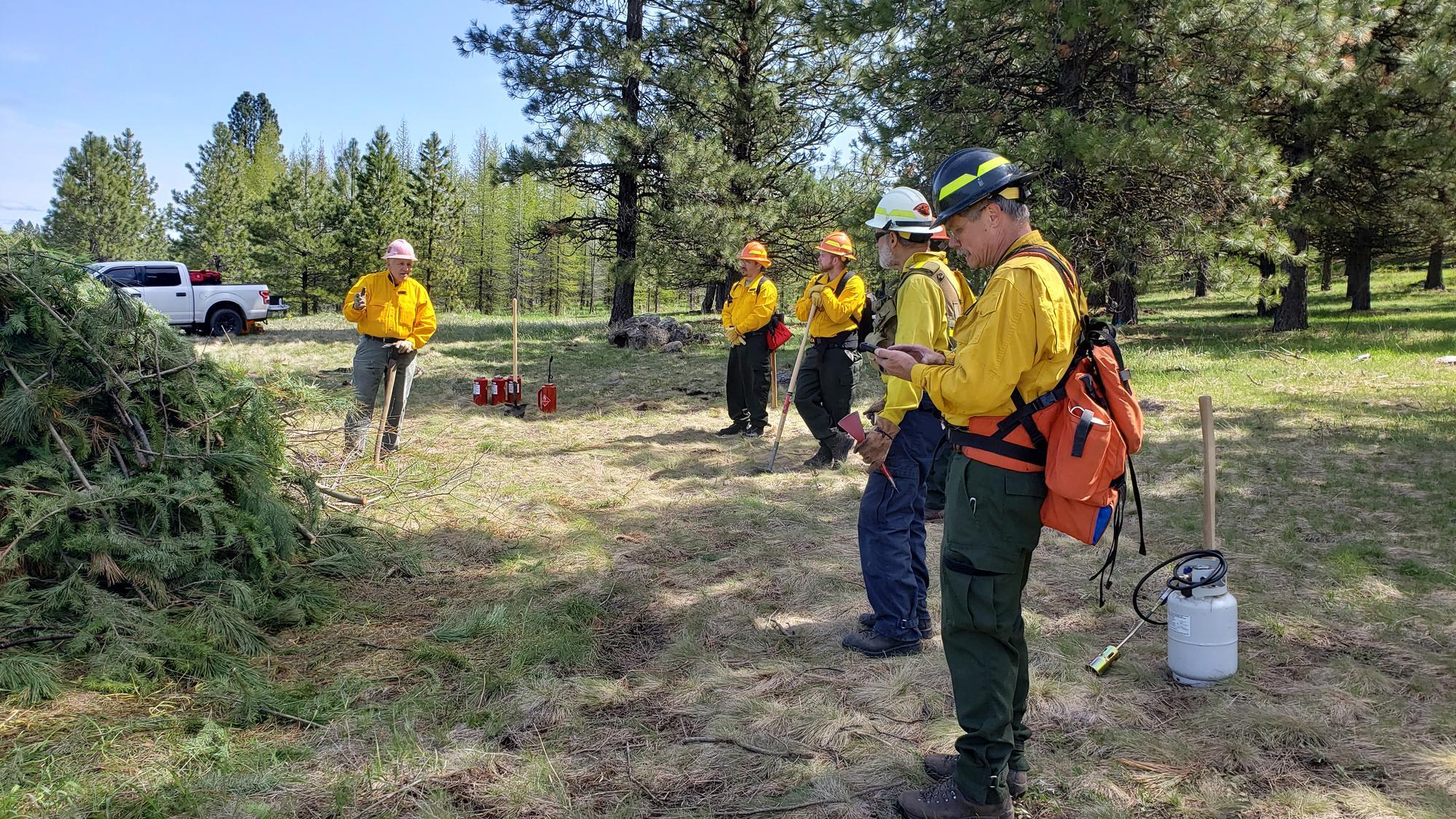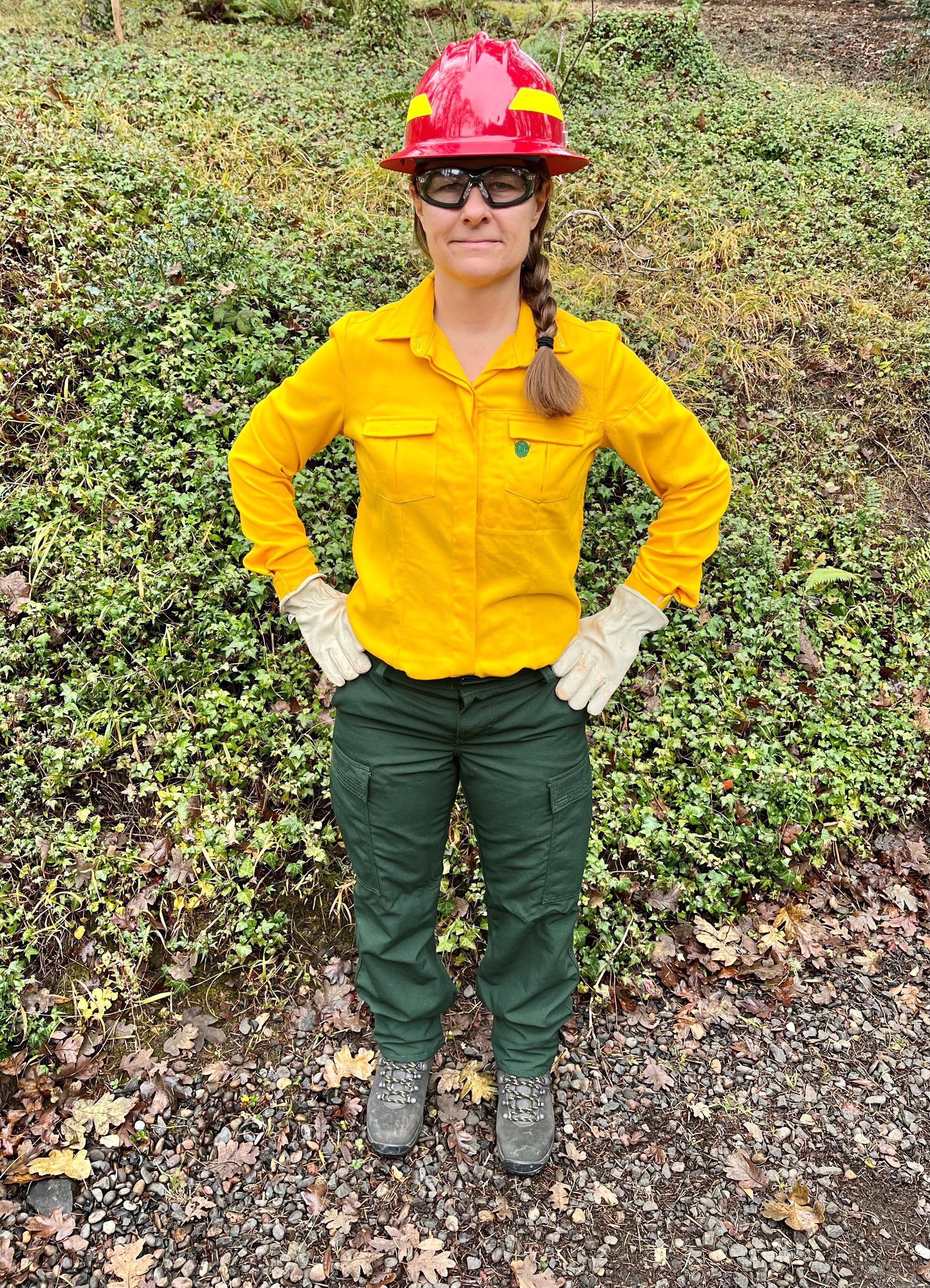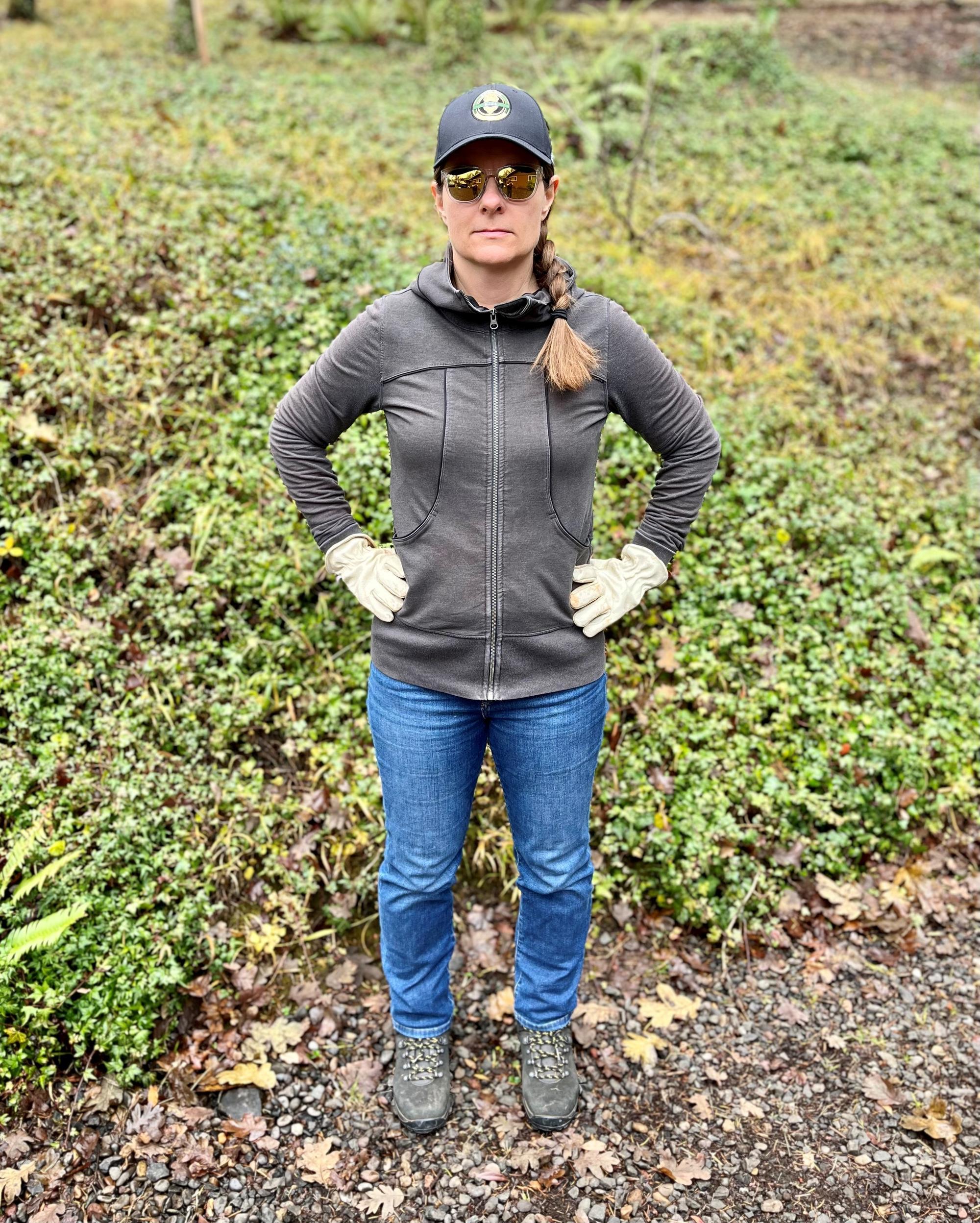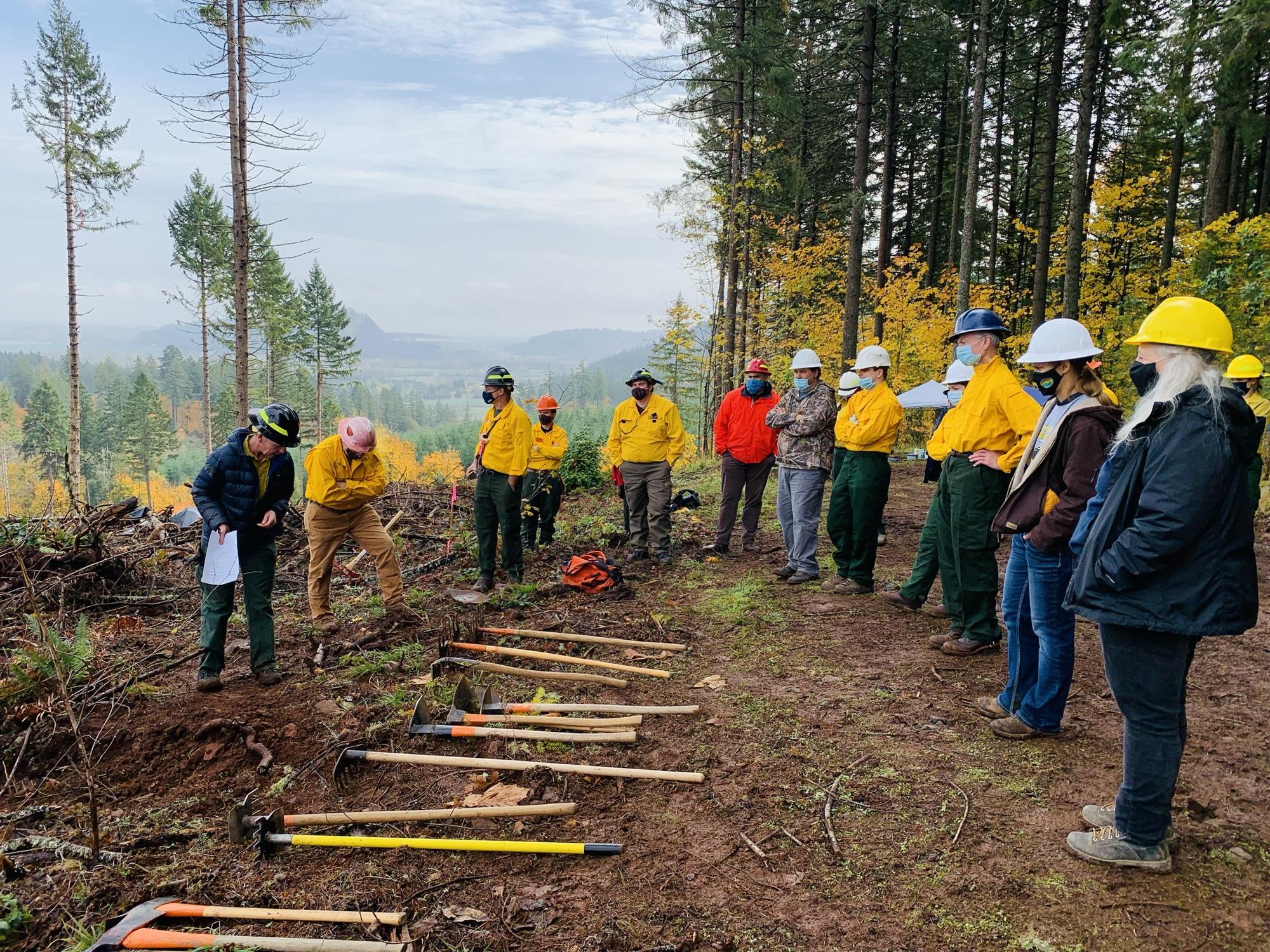Safety is the No. 1 priority when conducting a prescribed burn. Never compromise on your safety, the safety of those around you, or the safety of the land and its surroundings. A prescribed burn that does not follow safety protocols could lead to harm, injury or even death. An unsafe burn could also lead to an escaped fire that becomes a wildfire.
Safety first, safety always!
Personal protection and general care
What you wear matters
Whether you are using a chain saw or working with fire, always wear Personal Protective Equipment. PPE is crucial to the safe implementation of a prescribed burn. PPE consists of shirts, pants, gloves, footwear, headwear and protective eyewear.
PPE clothing can range from NOMEX™ or other flame-resistant fabric to 100% cotton or wool everyday clothing. Never wear clothing made of nylon, polyester or other synthetic material not labeled flame-resistant. These synthetic materials can melt or ignite and may cause severe injury to the wearer.
Shirts should contain no holes, rips or tears. Long sleeves should extend to the wrists and pants should completely cover the legs. Consider what type of vegetation you are burning. If you are burning blackberry or other thorny species, you may want to wear shirts and pants with more durable protection.
Wear gloves at all times. Gloves help protect against radiant heat, burning embers, hot parts of a drip torch and sharp objects. Gloves should be all leather and free of holes and synthetic materials.
Watch out for hazards while walking in a natural environment like a forest. Safe footwear is important. As with other PPE, never wear footwear made of flammable material. Closed-toed boots more than 8 inches tall with Vibram®-type soles provide the best protection. Don’t wear shoes with steel toes; these become dangerously hot when working around fire.
Protect your head, face, neck and ears from embers and other falling materials by wearing a fire helmet, or a cotton or wool cap or hat. Avoid hard hats or helmets made of non-heat-resistant plastic. Metal hard hats may be hazardous when working near powerlines, as smoke can cause powerlines to arc. Attach face shields and neck shrouds to a helmet for additional protection.
Embers, debris and smoke are all hazards on a prescribed fire. Mitigate your risk of eye injury or irritation by wearing safety glasses, goggles or other types of eye protection. Eye protection should fit securely and comfortably.
Watch your step
Watch for natural and human-made hazards. These include:
- Natural hazards such as uneven terrain, slopes, rocks, stumps, logs, rolling logs, snags and vegetation.
- Plants such as poison oak (Toxicodendron diversilobum). This plant contains urushiol, a highly allergenic compound. Touching these plants can cause an itchy rash.
- Stinging insects such as bees, or hornets, yellowjackets and other wasps.
- Human-made hazards such as fences, wells, pits and slash piles.
There are hazards associated with post-burn conditions as well, especially during mop-up. Examples include:
- Logs, stumps and roots that may still be burning.
- Holes where stumps or roots have burned down into the soil.
- Burned-out roots and trees destabilized by fire.
Wearing PPE can help protect you against natural and human-made hazards, but a keen eye for potential hazards is your best protection.
Take care of yourself
Heat exhaustion and dehydration are major safety concerns that must be taken seriously. Heat exhaustion is a form of exhaustion caused by working strenuously in a hot environment. Signs and symptoms can include:
- Headache
- Fainting, lightheadedness, dizziness
- General weakness
- Increased heavy sweating
- Nausea or vomiting
- Decreased urine output
If you or a crew member have any symptoms, drink water, seek shade or a cooler area to rest in, and use a cold compress or water to cool the body.
If symptoms persist or worsen, seek medical attention.
Prevention is the best defense against heat exhaustion and dehydration. Drink plenty of water and take periodic breaks in cooler areas while working on the burn.
Smoke from prescribed fire is another potential hazard on the fire line. Inhaling smoke, even briefly, can irritate the eyes, nose and throat. PPE such as eye protection, headwear and a respirator or mask can help minimize these effects. Don’t wear wet masks or handkerchiefs; these can become heated and cause life-threatening damage to lung tissue. People with heart disease, respiratory illness or lung disease, such as asthma and chronic obstructive pulmonary disease, may suffer serious health effects from smoke and should minimize exposure.
Smoke from a prescribed fire can also present hazardous consequences to a community. Burn plans must comply with the Oregon Smoke Management Plan. This plan incorporates weather forecasting and a wide range of best practices to minimize the impacts on public health, safety and visibility (Prescribed Fire Basics: Smoke Management, EM 9342).
Tool safety
Hand tools have many purposes in prescribed burns. A drip torch, for example, is a handheld ignition device used to set fire. Prescribed burners use scraping tools such as shovels, hoes and leaf rakes for firebreak construction and mop-up operations. Backpack pumps are useful for wetting down areas and suppressing fire. While there are many different tools, be sure to use the proper tool for the job. Practice safety measures when handling tools.
- Never run with a tool in hand.
- Keep a safe distance (about 10 feet) from other crew members.
- Hold the tool at its balance point on the handle when carrying.
- Keep the tool close to your body at your side and not on your shoulder.
- Position the tool on the downhill side of a slope.
- Cover any sharp edges with a sheath when not in use.
Take care of hand tools to ensure they remain in good working condition. Check that handles are smooth, free of cracks or splinters, and securely attached to the tool head. Clean tools after use and sharpen damaged or dull cutting edges with a hand file. A dull tool is a safety hazard and can cause fatigue during use.
Vehicle safety
People working on the burn unit often use four-wheel-drive and all-terrain vehicles. Follow best practices when using any vehicle or heavy equipment by turning headlights on, driving cautiously and not too fast, avoiding areas of thick smoke, and making sure that hoses, nozzles and equipment are secured. Service vehicles regularly.
Safety training
While safety training is not a requirement for landowners to use prescribed fire as a management tool, training is highly recommended. Agencies and firefighting organizations receive extensive training to conduct prescribed fires.
Structured courses include:
- Fire Shelter Training
- S-130 Firefighter Training
- S-133 Look Up, Look Down, Look Around
- S-134 LCES
- S-190 Introduction to Wildland Fire Behavior
- S-290 Intermediate Wildland Fire Behavior
- Red Cross or Medic First Aid
- First Responder/ Emergency Medical Responder
Day of the burn
Make sure safety is described in the burn plan
The person leading the burn, called the burn boss, will provide a verbal briefing on the day of the burn. Safety should be specifically addressed in this briefing and documented in a burn plan. A burn plan is a written document that helps to ensure a safe and effective prescribed burn. The burn plan outlines how everyone participating in the prescribed fire will conduct operations safely. The briefing and burn plan should describe:
- A medical emergency plan. This plan gives a clear picture of the process for quickly initiating help when situations arise. It includes the location of first-aid kits and identifies those with medical training.
- A communication plan. This plan details requirements and strategies for communicating with authorities and the public before a burn begins. It also emphasizes effective communication between everyone working during the burn, including proper use of radio frequencies and channels.
- Burn unit hazards. Keep a keen eye for potential natural and human-made hazards. Understand that hazards in the unit may change during the burn. For instance, it's important to consider your position on the slope in relation to the location of the active fire. Rolling material can ignite fuel below people working on the slope or across the fire line, putting crew members in danger.
- Public safety issues. Identify potential public safety issues, like a smoke intrusion, before the burn. Include mitigation strategies. Smoke can impede visibility outside the burn unit and create health issues, especially for people sensitive to smoke. Proactive attention to potential issues can ensure the safety of everyone.
- Fire line safety. Identify escape routes and safety zones (roads, waterways, rock pits, open areas, burned areas), and establish lookouts for possible danger. Clear and concise communications are imperative on the burn, as is each crew member’s personal responsibility to stay alert, keep calm, think clearly and act decisively.
- Safety during mop-up. Safety is as important at the end of the burn as before and during a burn. Wear appropriate PPE, watch out for hazards and take care of yourself. Manage fatigue during the later stages of the burn. It is also important to consider what equipment and resources are needed to completely extinguish the burn.
Safety information in the burn plan should be communicated to and reviewed by everyone on the prescribed fire.
Do a complete walk-through before lighting the burn
Before lighting the burn, do a complete walk-through of the area. Spot and point out hazards.
Factor in current and expected weather conditions. Weather conditions can evolve throughout the day. Keep informed of fire weather and forecasts (Prescribed Fire Basics: Fire Weather, EM 9385). Know what the fire is doing at all times. In windy or prolonged drought conditions, burning may be too risky. Weather hazards to watch out for during the burn include:
- Increasing winds
- Shifting wind direction
- Erratic winds
- Thunderstorms
- Lightning
- Decreasing humidity levels
- Increasing temperatures
Watch out for fuel moisture conditions in the various fuel sizes. If moisture is limited in fuels, small fuels are going to drive fire spread and larger fuels can have a big impact on fire intensity. Both rate of spread and intensity are significant safety considerations (Prescribed Fire Basics: Fuels, EM 9386, and Prescribed Fire Basics: Fire Behavior, EM 9341).
Conduct a small test burn to check that you are burning within the prescription and that fire is behaving as expected under current weather and fuel conditions.
Use a go/no-go checklist
When properly used, prescribed fire can be effective in many different vegetation types. It may even cost less than traditional vegetation management practices, like mastication. Before lighting a burn, however, review a go/no-go checklist. The checklist will ensure that critical aspects are not overlooked and your burn will successfully meet your objectives. Considerations for a go/no-go checklist include:
- Have you checked ALL the pre-burn considerations and preparation work identified in the prescribed fire plan?
- Have you obtained ALL required current and projected fire weather forecasts? Are they favorable?
- Are ALL prescription parameters met?
- Are ALL smoke management specifications met?
- Have ALL personnel been briefed on the project objectives, their assignment, safety hazards, escape routes and safety zones?
Situational awareness and common sense
Situational awareness and sound judgment are particularly important when working with fire. Situational awareness is the continual observation of your surroundings and the potential hazards you and other crew members face. While on the burn, avoid complacency, stay alert and never burn alone.
Wildfire suppression standards include 18 Watch Out Situations and Standard Firefighting Orders. If followed, these could reduce much of the risk of working with fire. These can also apply to prescribed burning. Together with common sense, these standards will contribute to a safe and successful prescribed burn.




